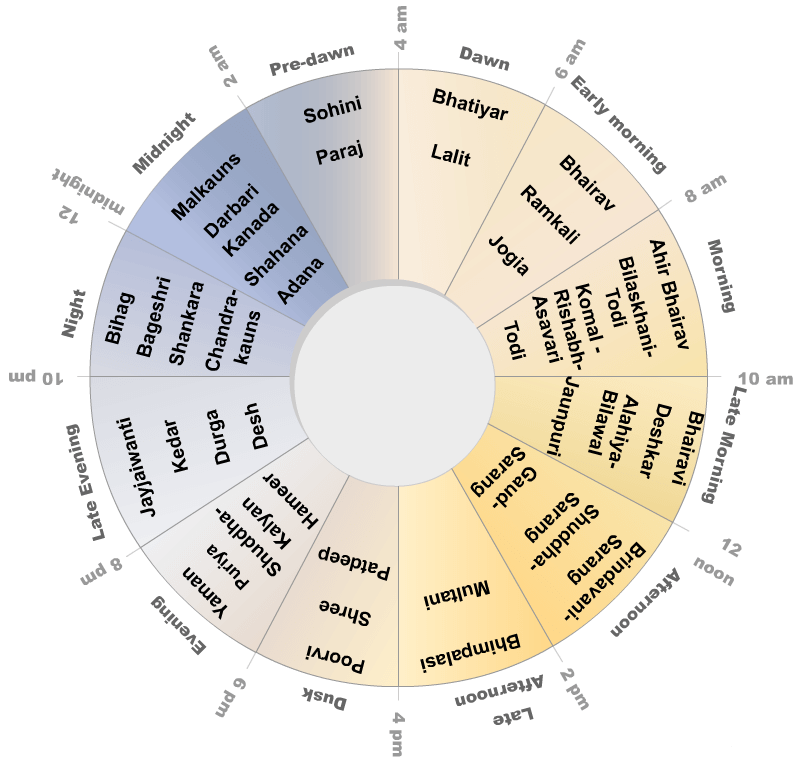What are Raga/Raag?
Raag or Raga is one of the most important concepts in Indian Classical Music. It is nothing but a collection of sur or swaras sung in a way which reflects an emotive mood or a feeling.
Rules of Raga
Each Raga has to follow 5 essential rules as are defined in Indian Classical Music. The Rules are as follows
- Each Raag must have at least 5 Swaras or Surs.
- Any one of the Swara Ma or Pa should be present in a raag.
- One Swara can have only one form i.e. either Shudh or Vikrit. For e.g . if a Raag uses Komal Ga then it cannot use Shudh Ga simultaneously.
- The notes used in Raag should always be in a order.They cannot be formed randomly. The Swaras should be in Aroh or Avroh.
- The Vadi and Samvadi Swara of a Raag has importance and should be used more frequently in a Raag performance . It gives a unique mood and emotion to a Raag .
There are many aspects related to Raga such as Thaat, Pakad, Chalan, Vistar, Samay Chakra etc.
In the below video I have described all aspects of Raga. You may choose to watch the video to get all the concepts or read this post.
Coming back to the moods created by Raag – we can look at couple of examples. Raag Maduvanti based songs reflect a romantic mood and Bageshri Raag based songs create a sombre mood.
Different moods are created due to choice of surs in the raga and the sequence of their usage.
The video above explains the concept of moods with examples.
To understand any Raag we need to know a few concepts like Thaat, Pakad, Jati, Chalan etc.
Let’s check out these concepts below.
In the past I have also created posts exploring some concepts like difference between Thaat and Pakad and 5 ways to describe Raag.
Thaat
Ragas can be grouped into multiple categories based on their swaras or sur.
This was devised by a doyen of Indian classical music Pandit Vishnu Narayan Bhatkande (1860-1936). He studied various gharanas and raags and classified Raags into 32 Thaats. Each Thaat was named after the most prominent Raag in that Thaat. For example Bilawal Thaat is named after Alhaiya Bilawal Raag.
Over the years these 32 Thaats gave way to 10 prominent Thaats which are used in Hindustani Classical Music these days.
To know more about Thaat and all the ten Thaats you may see our post where we have described Thaat and Pakad in depth.
All Ragas that are a part of a particular Thaat contain the same characterstics of the surs. For example all Ragas in Bilawal Thaat have Shudh Surs and all Ragas in Kalyan Thaat have Teevra Ma.
Jati
The next most important concept to understand a Raag is its Jati. Jati of a Raga is decided by the number of notes used in the Raga.
As such there are many Jatis but there are 3 major Jatis and many other mixed Jatis made out of combination of these 3 major Jatis.
The Raag having 5 notes are of Audav Jati i.e. 5 notes in Aroh and 5 in Avroh. For e.g. Bhoop Raag has 5 notes Sa Re Ga Pa Dh.
The Raga having 6 notes are known as Shadav Jati. They have 6 notes in both Aroh and Avroh.
The ones having all the 7 notes in Aaroh and Avroh are known as Sampoorna Jati Raag. Note that Sampoorna in Hindi means complete and the Ragas in this Jati have complete set of 7 Swaras.
There are some Ragas that are of mixed Jati ie they have different number of surs in Aroh and Avroh.
Those that have 5 notes in Aaroh and 6 in Avroh are said to belong to Audav–Shadav Jati.
Some have 6 notes in Aaroh and 7 in Avroh . They belong to Shadav-Sampoorna Jati.
Please refer the table below summarizing the prominent Jatis.
| Jati | Aroh Sur | Avroh Sur | Ragas | Example Raga |
|---|---|---|---|---|
| Audav | 5 | 5 | Bhoopali, Deshkar, Vibhaas, Hansdhwani, Durga, Hindol, Malkauns | Raag Bhoopali- Sa Re Ga Pa Dh |
| Shadav | 6 | 6 | Sohini, Gujari Todi | Gujari Todi-Sa Re Ga Ma Dh Ni.Re Ga Dh Ni komal and Ma teevr. |
| Sampoorna | 7 | 7 | Ahir Bhairav, Bhairavi, Darbari Kanada, Kafi | Ahir Bhairav-Sa Re Ga Ma Pa Dh Ni.Re and Ni komal. |
| Shadav Sampoorna | 6 | 7 | Khamaj, Kedar, Tilak Kamod | Raag Kedar-Aaroh-Sa Ma Ga Pa Dh Ni. Avroh-Sa’Ni Dh Pa Ma(teevr) Ga Re Sa. |
| Audav Sampoorna | 5 | 7 | Des | Aaroh-Sa Re Ma Pa Ni. Avroh-Ni (Komal)Dh Pa Ma Ga Re Sa. |
Swaras in Raag – Vadi , Samvadi & Varjit
The most important Swara of a Raag is known as its Vadi Swara.
The second most important Swara of a Raag is known as its Samvadi Swar.
The Swara which is not included in a Raga is known as its Varjit Swar.
We need to know these Swaras so that we can know which Swaras are important and which Swaras do not appear in a particular Raag.
But by knowing the Swaras of a Raag is it possible to sing a Raag? No as there are many Ragas which have same notes i.e. same Thaat, same Jati but the way in which they are sung are very different form one another.
Chalan and Pakad of a Raag describe the way in which the Raag is supposed to be sung.
Thus in order to sing the Raag perfectly it is very important to know the Chalan and Pakad of a Raag.
Aroh and Avroh
Aroh of a Raag is the sequence of notes appearing in the Raag in ascending order from Shadaj(Sa) of middle Octave to Sa of higher Octave
Avroh is the sequence of notes in descending order from Sa of Higher Octave to Sa of Middle Octave.
For e.g. Raag Bhoop :
Aroh – Sa Re Ga Pa Dh .
Avroh-Sa’ Dh Pa Ga Re.
Aaroh and Avroh of a Raag is generally sung by basic level singers to introduce a Raag to the audience. Singers of intermediate and advanced level start Raag presentation by Chalan or Pakad.
You may also watch the video below to know more about Aroh and Avroh
Or you may check out this post on Aroh and Avroh that describes the concept of Aroh and Avroh in detail.
Pakad
Pakad is short musical phrase which shows the essence of a Raag. It is a brief description of Raag and indicates how it needs to be sung. Note that Pakad doesn’t give the full clarity about singing a Raag but only a basic understanding of Raag.
This video talks about Thaat and Pakad in greater detail.
The clarity of singing a Raag is given by the Chalan of a Raag.
Chalan
Chalan is much more enhanced version of a Pakad which shows the way the Raag is sung in a desciptive form. It rather tells the development of a Raag .
For e.g Raag Yaman is a Sampoorna Jati Raag. But the way the Raag is presented makes it very different. This can be clearly understood by the Chalan of the Raag.
Demonstration of two Raga are shown in the video.
Raag Darbari and Raag Jaunpuri belong to same That , have same notes still when they are presented they seem to be quite different. It just because both the Ragas have different Chalan.
For e.g Raag Darbari is generally sung in lower Octave with lots of Andolan (dragging of notes) in Dh and Ga.
Raag Jaunpuri is however sung in middle and higher Octave with straight notes.
You can refer to this video on Raga at the beginning of the page to have clear understanding as I have sung the Ragas to demonstrate this.
Once Chalan and Pakad are clear ,we go to the next step ie the Vistar of a Raag.
Vistar
Vistar of a Raag is detailed elaboration of a Raga, much more elaborate than the Chalan. It is developed by the singer himself and is guided by his understanding and adaptation of the Raag.
An expert classical singer develops the Raag by using different ornamentation or Alankar . The full version or understanding of a Raag can be done by its Vistar.
Usually expert singers sing Vistar and give Raga an individuality of their own.
Raag classification are also done on the basis of Raag Samay chakra .
We also have a very interesting post on 5 ways to describing Ragas that you can read to understand Thaat, Pakad, Chalan and Vistar or view the video below:
Samay Chakra
Nature of a Raag, the timings of a singing a particular Raag can be understood by the Raag Samay Chakra.
Although there are many exceptions to this theory , but generally it is belived that time of singing a Raag decides its nature or the mood that it is trying to express.
For e.g. The Ragas sung in the morning are generally full of energy while the ones sung in the evening are generally emotional, romantic.
A day is divided into 4 phases or Prahar. Each Prahar or phase has a duration of 6 hours. First Prahar of the day starts at 6 AM.
For e.g. Raag Ahir Bhairav is a morning Raag and is full of energy, while Raag Bageshri or Darbari are sung in the third phase of night so they are intense full of emotions . Raag Bhimplasi is sung in the third phase of day so it is a romantic Raag.
The video above demonstrates this at the beginning or the video and also in the section where the Raag Samay Chakra is being talked about.
Below is the chart depicting different Ragas and the Phase or Prahar during which they should be sung.

The video at the beginning of this posts demonstrates all the concepts through Raag Bhimplasi. This part is towards the end of the video.
Do subscribe to our Youtube Channel for receiving regular videos about concepts of Indian Classical Music.
Contact us by writing emails to musicwithaditi[at]gmail.com or by messaging us on our Facebook page to reach us.

